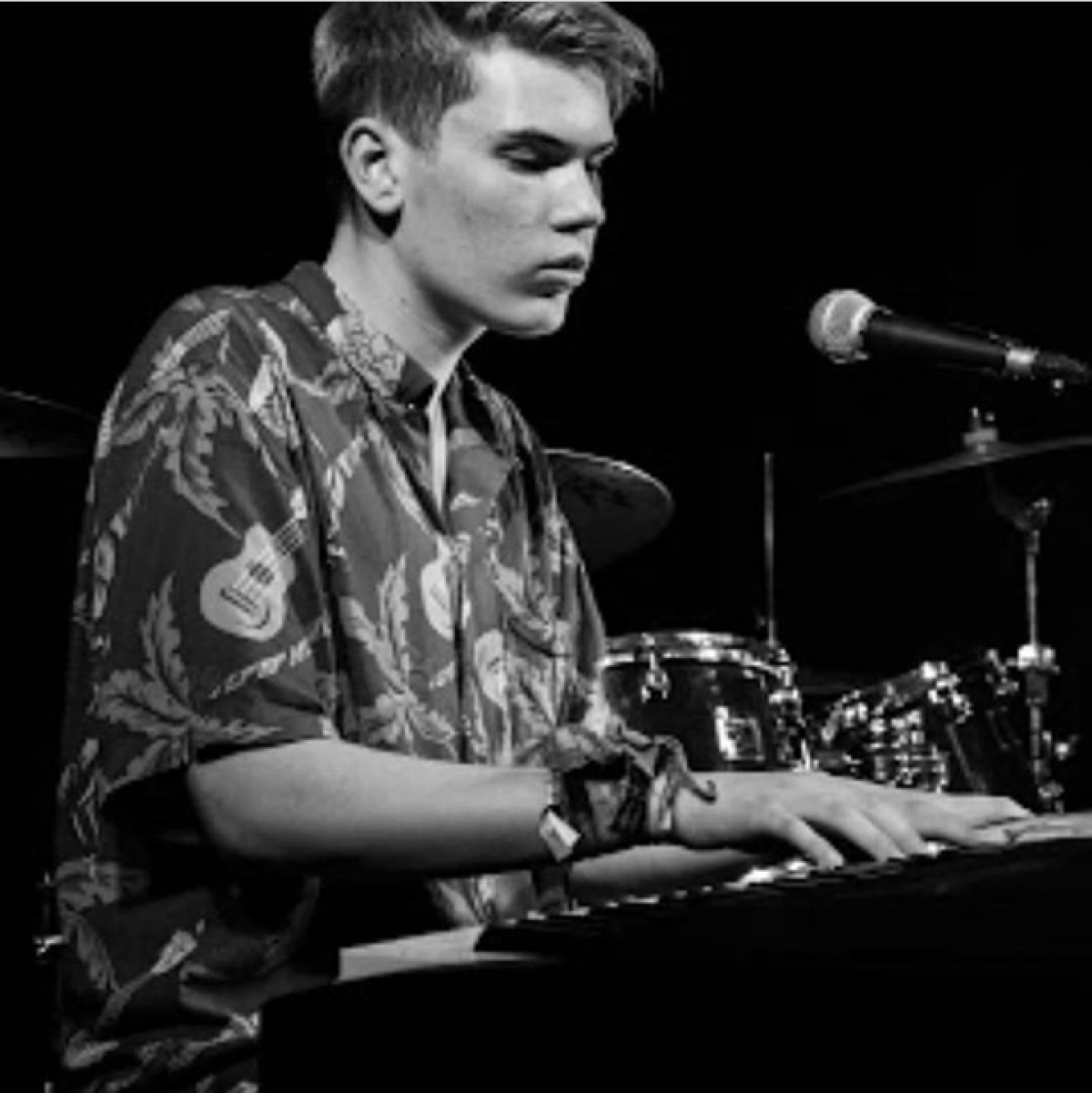Musical artists that have influenced my sound
Gogo Penguin
The video above comprises of 3 of Gogo penguin’s compositions. These are Raven, Bardo and Window which are all from their latest album, a humdrum star. Gogo penguin are a band that I have heavily got into over the past few months and one that continue to surprise me with the intricacies and beauty of their songs. A hugely interesting part of their sound as a band is that they often don’t sound like a stereotypical jazz trio at all which is mainly down to the modifications that each musician has added to their instruments as well as their technique.
The pianists rhythms and melodies have really impacted on me as a piano player. Originally he was from a classical background and you can hear the influences in his playing as he develops little melody lines and and uses lots of chord inversions.
The bassists sound is really interesting and he often uses a bowed approach in order to add to the atmosphere of a piece by creating pockets of space.
The drummer is incredibly talented and has developed a sound that is very similar to other jazz bands playing this contemporary style of jazz that really explores different ideas and rhythms as well as taking ideas from genres including drum and bass.
These 3 players overall create a really interesting and beautiful sound which is completely different to the sound that you’d imagine if someone mentioned a standard jazz piano trio to you.
Olafur Arnalds
Olafur Arnalds is an artist that I have only begun listening to very recently as Nic Sykes recommended him to me just before the start of this project. As soon as I began listening to his music, it created a large effect on me as the combination of the piano and the strings creates such a beautiful sound and atmosphere. At the time, I was contemplating collaborating with a jazz violinist in order to go down a more gypsy jazz route however after hearing a number of Olafur’s compositions , I decided to change course and start writing like him. The piano pieces that I was writing at the time were more down the reflective route therefore this approach suited them perfectly. Unfortunately I do not have the same equipment as Olafur, however a simpler approach has allowed me to start from the ground up and build upon my original ideas which I believe is the best way to compose. I will talk more about my writing techniques in the composition tab.
Overall listening to Olafur exposed me to the genre of ambient music and allowed me to understand that it is an extremely popular style. When first approaching the idea of creating jazz compositions, I was unsure in which lines I could cross in terms of harmonic and instrumental ideas. However after listening to this style of music, I began to understand that artists mix up different genres all of the time and that I shouldn’t be afraid to break away and experiment with different sounds in order to develop my own.
Mammal Hands
Mammal hands are another band that fall into that genre of ambient, contemporary jazz. They have been a band that I have followed for a relatively long time and one that continue to create incredible compositions.
At a first glance, the trio is made up of a saxophonist,a pianist and a drummer. The interesting thing about this is the fact that there is no bassist which adds so much space to their sound. It also frees up the pianist to develop bass lines and ideas.
This sound is very interesting to me as originally our lineup included myself on piano, Fraser on guitar and Shaun on the drums which meant that I had a lot more space to utilise meaning that I could largely dictate the texture and build up of the piece.
Tom Rosenthal
Tom Rosenthal hugely inspired me as a composer in the fact that he seems to express so much vulnerability in his lyrics and the way in which he sings. He has created a lot of beautiful compositions and makes some incredible music videos to go along with them. HIs compositions are also largely piano based and feature some great harmonies. Personally I really like his writing style on the piano in which everything is continuously moving and feels like it has a purpose. This song has a perfect flow to it and it feels as if the music is kind of effortlessly floating which gives it a really nice texture overall.
Robert Glasper
Robert Glasper is someone that I’ve listened to in bits over the past couple of months and I’ve really liked what I’ve heard. Here is an awesome concert featuring Robert Glasper with his trio and Bilal Oliver. It combines an awesome groove with some nice chords and powerful lyrics.
Robert Glasper’s feel on the piano is incredible to listen to and he plays some really nice melodic lines sometimes with both of his hands at once which is a technique that I find intriguing.
I’d be very interested in this project to delve into one of his arrangements or compositions so as to understand some of the chord voicing’s and improvised lines.
Nubiyan Twist
Nubiyan Twist are a really interesting jazz band that mxi genres such as afrobeat, dub and hi hop to create some rally interesting music. Here they are with a song featuring KOG who is a vocalist in a band called KOG and the zongo brigade who play a similar type of music. Listening to Nubiyan Twist is an interesting experience as as they combine so many different styles, there’s parts to their songs that can sound completely different to one another and yet they arrange it to make sure that it still flows. As I have been influenced by a lot of genres in my lyrical and musical writing style , I found this interesting when trying to break out of the idea of writing in a specific way for a specific genre. After listening to bands like Nubiyan twist, it became aware to me that we could mix all of these different styles and musical elements and create some really interesting music.
Kamasi Washington
Kamasi Washington is a jazz saxophonist and artist that I absolutely adore. He brings such a different sound to the table and manages to mix so many genres whilst still retaining so many jazz values. By utilising huge horn, rhythm and choral sections Kamasi always produces an epic sound which is full of different things and orchestrated in such a brilliant way. His songs are ones that I often play along to on saxophone in order to try and catch some sort of similar magic to him. Although this often fails, it is still interesting to analyse the lines that he is performing on saxophone both from the melody to his improvisations.
Roy Hargorve
Strasbourg St Denis is a song that is beautifully crafter by Roy Hargrove. Roy Hargrove is a musician that I really admire as he is able to craft so many beautiful solos as well as getting the best out of the rest of his band. Unfortunately Roy passed away last year, however this classic will probably always remain as one of my favourite jazz songs. The question and answer sax and trumpet lines are one small detail from a host of ideas that I absolutely love within this song. The piano solo is outrageous and it’s refreshing to see a quintet performing like this in modern day jazz. Not that they aren’t common, but so many artists have moved towards electronic instruments that it is nice to have a grand piano pop up every now and then. The drop down riff was also an influential part of my songwriting and you will see how I utilised that idea in the beautiful escape.
Loyle Carner
I thought that Loyle Carners music couldn’t get any better and then he released this outrageous track with Jorja Smith. Loyle Carners music is a great example of how a simple approach to music can create something very beautiful. One of my major faults as a pianist is the fact that I often overplay both when performing solo and when supporting a singer or soloist. When listening to Loyle Carners music, I understand that less is more and that by taking a simpler approach to accompanying someone will allow them to blossom. This track is great in that it fully demonstrates how I would like a singer or singers to interact with the music on my compositions. Loyle Carner has a brilliant flow as a rapper and his songs are often more like stories in the way that he tells the lyrics which is my favourite style of rapping and I love the idea of songs telling stories.
Jorja Smith
I discovered Jorja smith around 6 months ago and was blown away by her incredible voice and song writing skills. The lyrics in her songs are so well structured and beautiful and fit perfectly with the jazzy chords that sit behind her. I decided to play along to lost and found on the piano and was really interested to see that although the chord progression was very repetitive, it contained mostly 7 chords as well as an interesting harmonic progression. It’s interesting to see a range of artists becoming very popular off of the back of this jazzy laid back music and it is inspirational to see a real opportunity for jazz leaning artists becoming bigger and bigger.
The Skints
The skints are a band that I have listened to for a few years and continuously enjoy to do so. They are a really interesting band that mix elements of dub, reggae and hip hop. A very interesting part for me as that the main vocalist plays keyboard as well as saxophone which is something that I am thinking of trying to do for mother fungus. All of their songs are incredibly well structured and they have a very similar band set up to us which makes it very interesting to see the potential sort f sound we could create.
Lowkey
Low key is a rapper that I was lucky enough to discover at a festival last year. I had already heard great things about him but I was amazed by his lyrical content as well as the way in which he performed. I think that the best performances are always the ones that leave you with goosebumps and constantly thinking about the songs that you have witnessed. Over the past four years of my life, I have got involved with politics and always kept an eye open on what’s happening in the world. I have often tried to write about the way that I feel about certain things in the world and when I started listening to low key, I began to develop more of an understanding on how to approach it. Low key creates a range of interesting beats with different samples and has an excellent flow , however he is saying many significant things which is an extra appeal to his music. Personally, I think that as a performing musician, I have been gifted the opportunity to express my opinion to an audience and that the lyrics that I create should hold some significance and empower people. Of course this might not be the case for every song and the lyrics will mean different things to different people, however I would like to start writing in this way.
Jazz Harmonic Structures and Chords
The kind of introductory jazz chord progression is a 2-5-1.
Here is a diagram of a major 2-5-1

Here is a diagram of a minor 2-5-1

I have been comfortable with playing major 2-5-1s for a while, however I have recently been experimenting with minor 2-5-1’s and I have found that they have a really interesting sound. When adding 9ths to the chords, you generally follow the key.
For example for a major 2-5-1 in C , the 9th of D would be an E, the 9th of the G would be an A and the 9th of the C would be a D. You can then go ahead and add more extensions if you want and take away notes so as to change the sound of that chord.
For the minor 2-5-1, the D half diminished would include a flat 9 as in the harmonic minor, the E is flattened, the same can be said for the G dominant which would contain an Aflat and it resolves to a Cminor 9 which contains a D natural for its 9th.
Adding extensions allows me to experiment with a more jazzy sound as well as create some interesting two handed voicing’s. It also allows me to create something called rootless voicings which I shall talk more about further on.
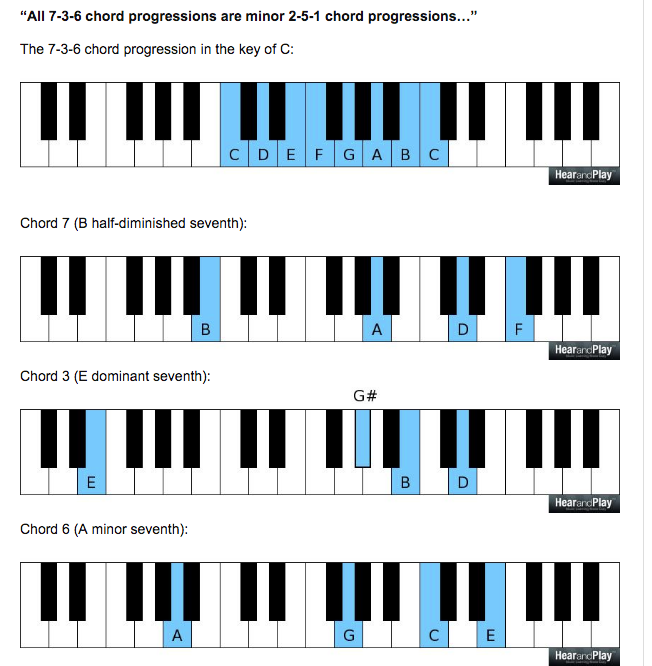
When I was researching the 2-5-1s , I came across the 7-3-6 progression, interestingly a 7-3-6 progress is exactly the same as a 2-5-1, however in the example show it adds a sharpened 5th to the key of C, this could be an interesting thing to explore within composition.
Sus Chords
Sus chords are something that have eluded me throughout my playing to this point, although recently I have begun to explore pieces which are centered around sus chords such as Maiden Voyage by Herbie Hancock. Hancock was well known for using sus chords and it is a huge part of his sound. Sus chords are interesting in that they are neither bound to a major or minor tonality, as the 3rd is removed and instead replaced by the 2nd or 4th or sometimes both.
Whilst looking at some jazz theory, I came across a great explanation of sus chords in Mark Levines jazz piano book, which features some great example diagrams. Below you can see Levine’s introductory view to sus chords.
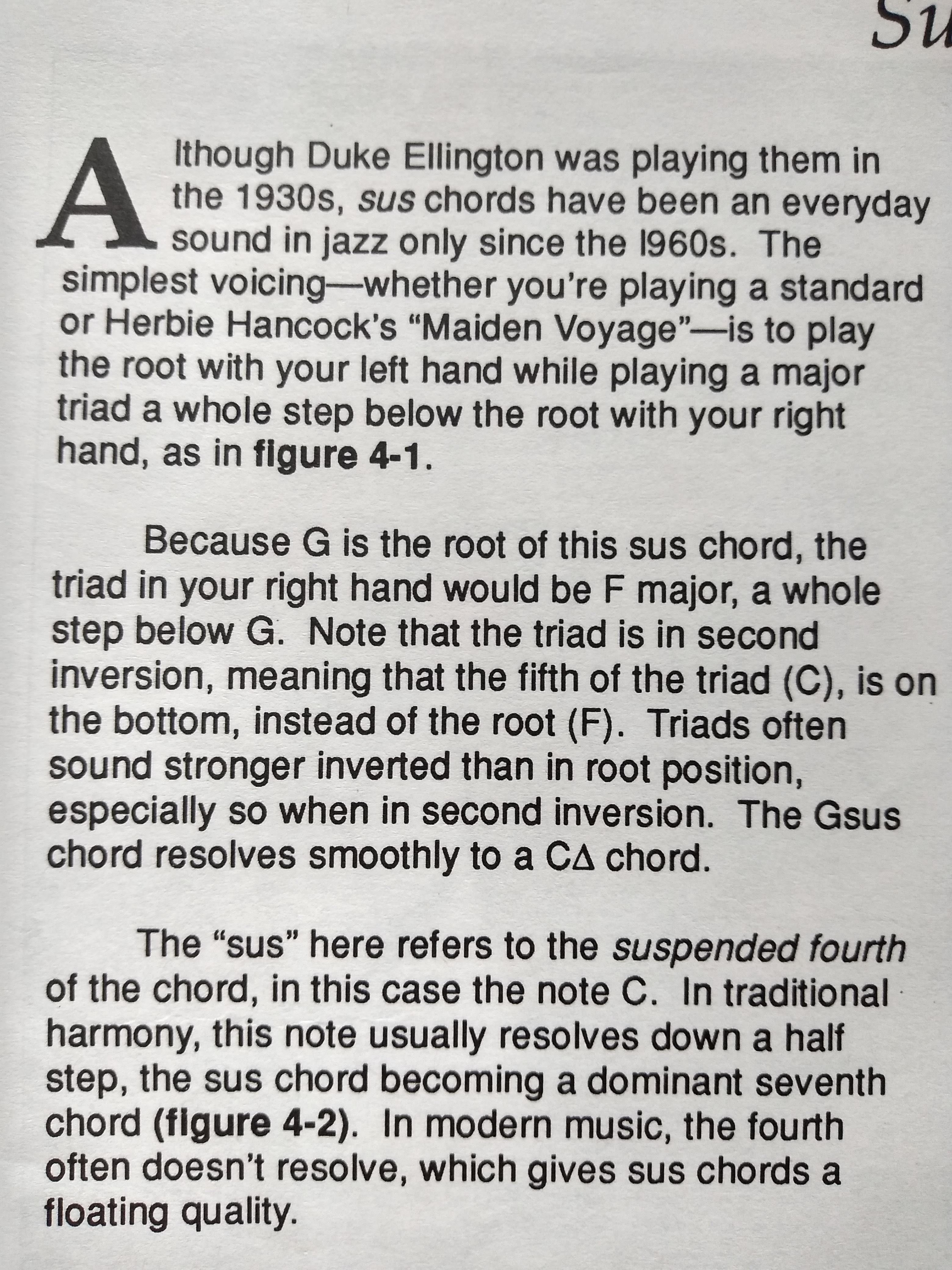
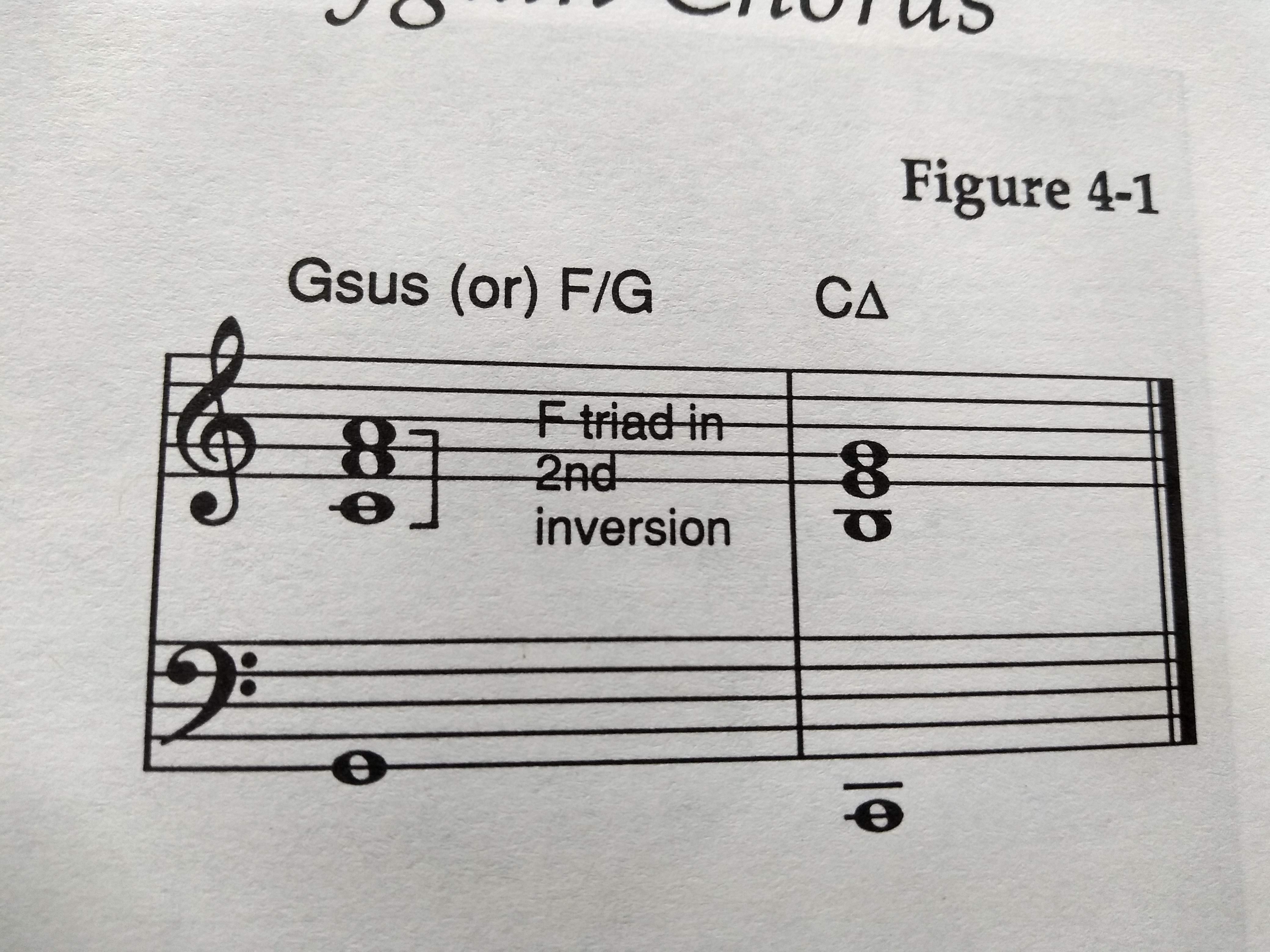
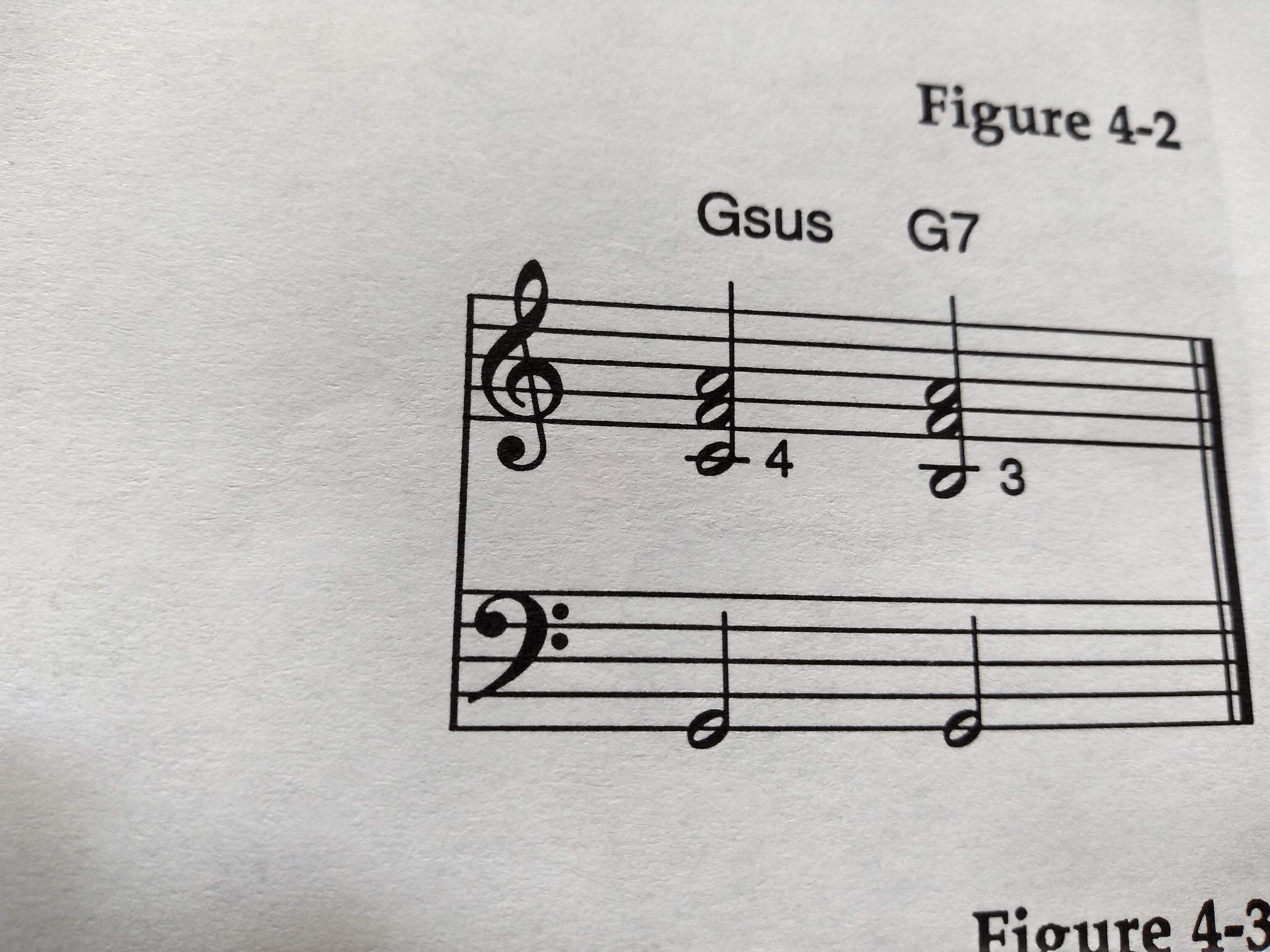
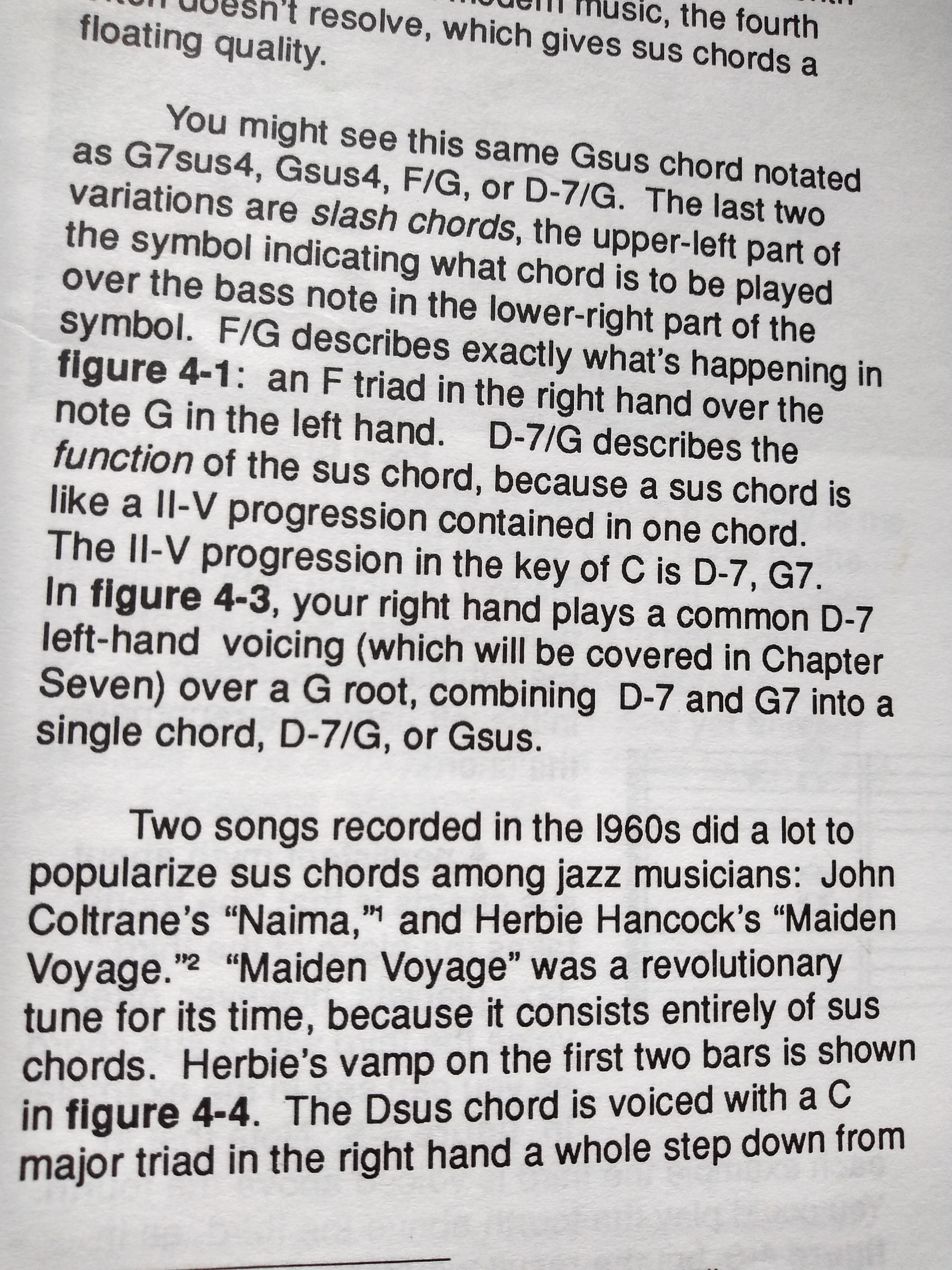
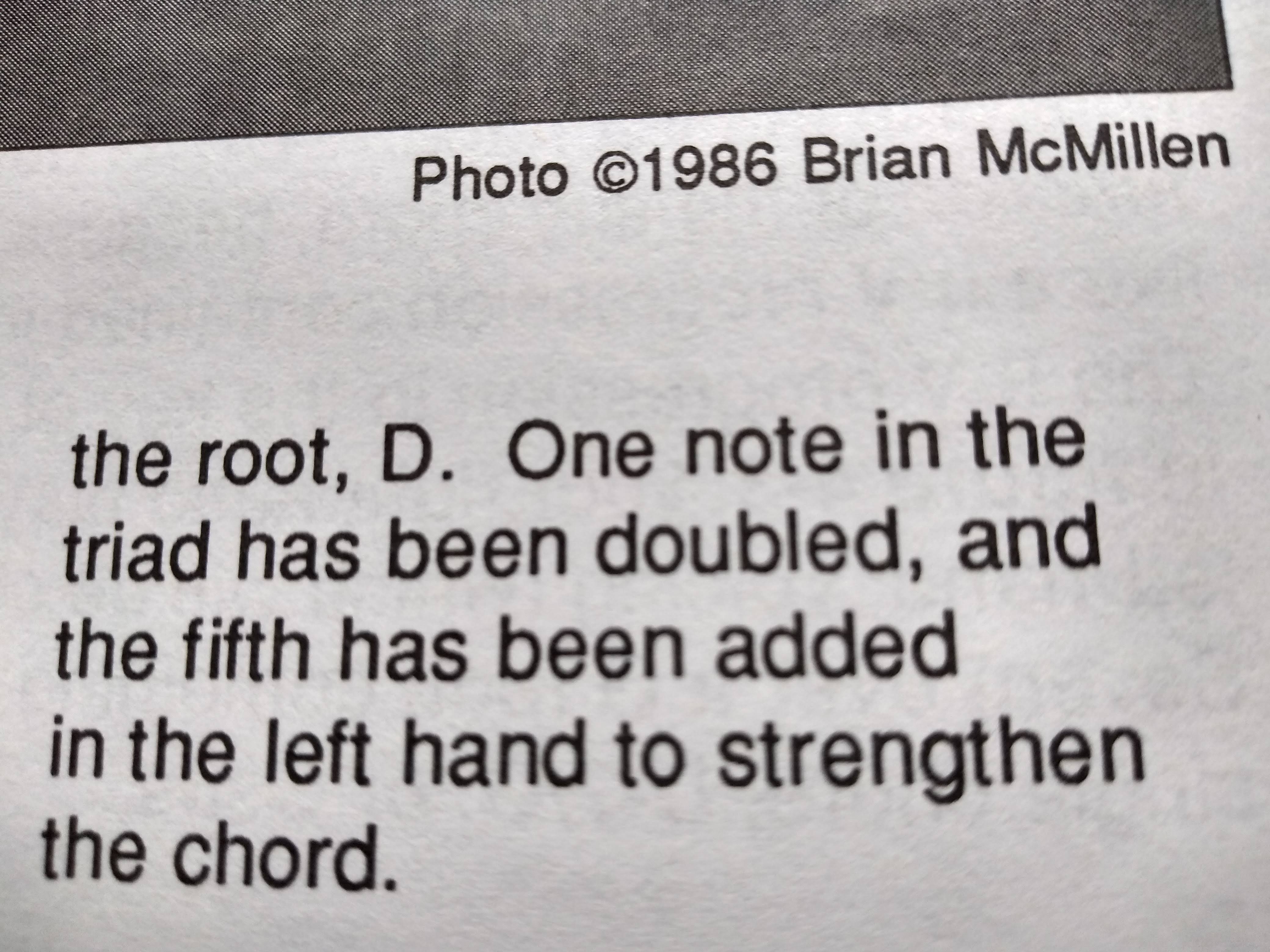
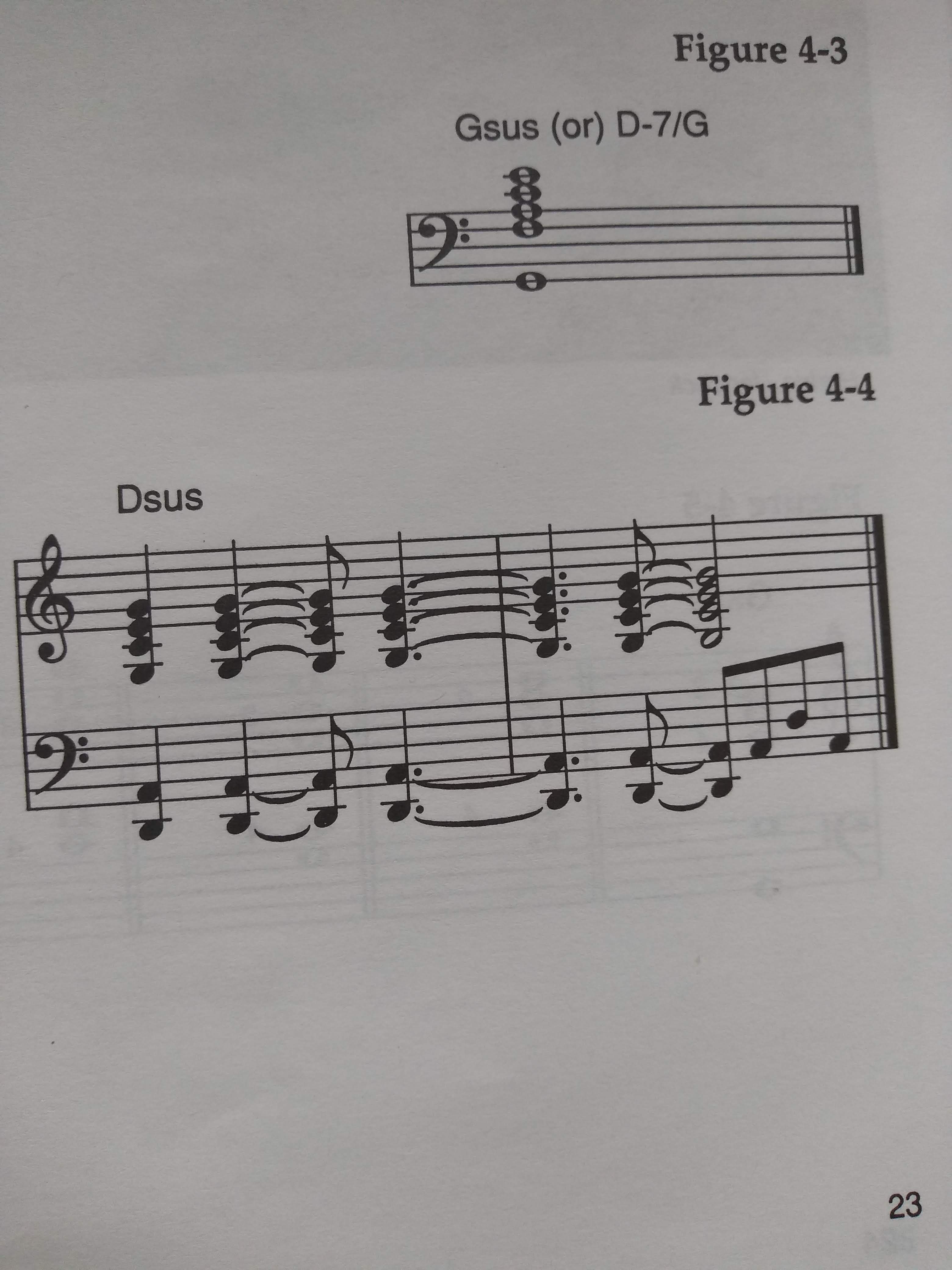
Levine, M. (1989). The Jazz Piano Book. Petaluma, CA: Sher Music.
I find that even by playing around with the simplest sus chord which is a major triad in the right hand being a tone below the route note in the left hand allows for some interesting chord progressions. As Levine goes on to say, there are so many ways in which you can add notes in order to strengthen or alter the sound of the sus chord further. For example, if I play a major seventh chord in my right hand being a tone below the route in my left hand, I will have created a sus 13 chord.
A sus 13 voiced in this way would contain the following notes.Dsus 13 or Cmaj7/D, includes D (tonic) , C (seventh) , E (ninth), G ( elevnth or sus4) and B (thirteenth). Having the knowledge to create chords like these from knowing my major seven chords is a great way to begin voicing more complicated extended chords.
Soloing
Improvised solos have always been a huge part of the identity of jazz. Many jazz musicians are often recognised for there cleverness or soulful approaches when it comes to improvising and in my opinion, it is one of the best ways to show off your skills as a musician. Many jazz and music students spend hours of their time on transcribing other artists solos so as to learn the phrasing techniques that they use. I think that improvised lines are best compared to improvised speech and that the best musicians have the ability to strike powerful imagery and feeling into their solos which really effects the listener, just as an impassioned speech might do the same. I talked in detail about jazz improvisation in my previous project this year (project three) and a more detailed synopsis can be found there.
Just like learning to speak, learning the language of music takes years to develop , so it isn’t a surprise that I am in my very early stages as a musician. In this project, I therefore decided to look into improvisation techniques that would help me develop as a musician.
Here is a great video on improvisation by my piano teacher on learning and developing improvisation.
The video is essentially split into three parts, in the first part Paul talks about different techniques that you can do in order to solo over a jazz standard such as Autumn Leaves. The techniques explained in the video, are something that I often try to do in my practice routine however are something that I should focus on much more. It is important to practice techniques such as this in order to develop a better feel for the piano by being able to play more fluid.
The second part of this video talks about moving different ideas around. This is something that I have been attempting to improve throughout this project, as by repeating different ideas you create somme significance to them and are able to start crafting some sort of story. My current technique at the moment is one that is too hurried and I get too over excited when improvising. Less is always more when soloing and it is very hard to admit that and even harder to implement it into your performance. However that’s why artists such as Jarret and Mehldau are referred to as the best, as they are able to pick out incredible phrases and embellish them with such conviction.
The third part talks about approach notes which is a technique that Bill Evans uses. I think I am a way of implementing these fluidly into my playing, however it doesn’t harm to try and I will experiment with different ideas such as this.
Dissecting Songs
Hopopono – Gogo Penguin
Here is one of my favourite songs by one of my current favourite bands. I love the simplicity of the melodies that Chris Illingworth plays over a busier left hand and how it builds from being so simple at the start to having such a great flow further on in the piece.
Although there is some modulation and Illingworth gets busier as the piece goes on, the initial idea for the song is very simple. I therefore tried to work out the idea by ear and my attempt can be seen below.
Chameleon – Herbie Hancock
Here is Herbie Hancock’s iconic tune Chameleon. Chameleon is one of my favourite compositions by Hancock as it combines some crazy synths with a great horn section as well as a crazy bass sound. I was listening to Chameleon whilst sat at my keyboard at home and decided to try and work out the song by ear. I was very surprised to see how simple all of the parts that fitted together were. In fact , the horn riffs were mainly diatonic and it was all very repetitive. Of course , Hancock went into a crazy solo afterwards but a lot of the licks or runs that he was using were very straightforward and it was more about the feeling of the piece.
Here is a video of me playing the bass line to Chameleon as well as the two main horn riffs.
In my playing as a pianist, I often have the tendency to overplay and therefore by studying Herbie Hancock and Gogo Penguin, I have now seen that the professionals and legends are using very simple phrases and that there is no reason why I can’t do the same to create great sounding songs.
Writing Lyrics
Here is a really interesting and helpful video on some songwriting tips from an artist that I really respect, Tom Rosenthal.
An interesting thing he talks about is the importance of flow and that you should choose that over structure. This is a big part of the way that I write as a musician. When I wrote the two rap songs run and hide and the beautiful escape, structure wasn’t a big part of the way that I came up with them it was more about the flow of the song delivering the kind of message that I wanted.
Tom also talks about being free on your instrument and not worrying about your ability. I feel that I have recently come to a point where I am happy and feel excited to experiment more on the piano as well as with lyrics and the saxophone. I think that this has morphed out of a mixture of a growing confidence within myself as well as the positive feedback that people have given to me about my playing. I now feel confident in sitting down at the piano and just improvising with an idea which is something that is quite new to me. A lot of these improvisations have resulted in songs that I really like and have refined into songs that I will be playing at my final performance.
For a while I felt that need to maybe compete more with other musicians, however I have now come to accept that although musicians might be technically better than one another, everyone has a different approach to an instrument and have a different way of writing music and therefore you don’t have to be the best at something to write a good song. Many of my musical heroes aren’t the best pianists or musicians in the world but write some incredible music.
Writing lyrics is something that I never thought I would do and I have only started recently. The surprising aspect for me is that sometimes lyrics come to me in a rush of ideas and sometimes I can’t think of anything. Often wheneverI get a thought of a lyric or idea, I write it down or record it on my phone meaning that I can go back and work on it when I am feeling more creative. I have also started to envisage different melody lines and chord progressions, for example the horn line for the beautiful escape was something that I imagined in my head before singing and recording onto my phone. I then worked out the pitch for it and recreated it on the saxophone.
These sorts of things amaze me all the time and through the constant testing of ideas, I am starting to write better songs.
Performing live
I decided to research a range of artists from similar genres to ours so as to study their performance techniques in order to work out what is the best for us.
Brockhampton are a relatively new hip hop group who came to prominence on the scene after releasing three albums in one year. This video of them performing live is really exciting to watch as they are constantly hyping up the crowd and bring so much energy to their performance.
It is very interesting to see a rap group perform with the backing of a strings section and for those musicians to all be dressed up in the same way, as explorers. Having the prop of a helicopter on stage also adds a lot of mystery to the set and provides opportunities for dances and revealing guest singers or members of the group.
Although some of our songs do contain rapping and are quite hip hop based, the majority of our band are musicians not rappers and therefore a set up like this wouldn’t work. However it would be interesting to see if we could develop with this much energy and the different ways that we can hype the crowd up.
The Robert Glasper experiment perform in a very similar way to so many jazz bands that I have seen. The rhythm section are towards the back and are mainly focused on fitting in with one another, whereas the vibes sax and vocalist are placed further forward. Every musician in the band have complete respect for one another and only really take the front seat when soloing. Even though this is Robert Glasper’s band, he remains very reserved throughout the performance which is interesting to see. The way in which the band performs makes it so much more about the music and as the musicians are trying to express themselves through their instruments, this is a very effective tactic as it makes the listener focus on and reflect on the message of their music. This contrasts with Brockhampton’s approach, as even though their music is important to them the demographic that they’re aimed at are wanting to go out and dance at their gigs.
Moonchild are a Neo soul group that often perform of a four piece. The interesting thing about their setup is that they have two keyboard players which offers for a very different visual representation than to most bands. The reason that I chose this performance was partly influenced by their instrumentation as well as the way that they interact with the audience and also the amazing sound of their music. I love the clicking at the start and how the singer is the main focal point for the band. Although the two keyboardists and the drummer are bobbing with the music, the singer is the one engaging with the audience. This is a good example of how I think that our band could potentially operate with Shy’yan being the main focal point of the band. The whistling part at the end or something along those lines of interaction would be great to have as part of our live appearance going forward and therefore we’ll see what we develop.
